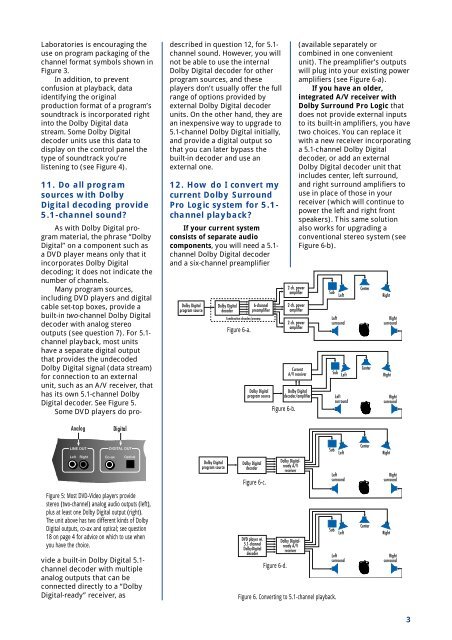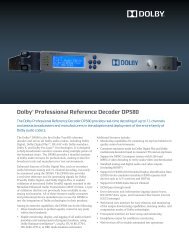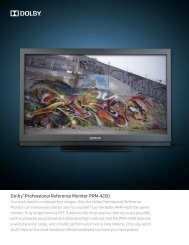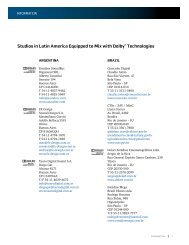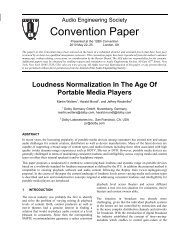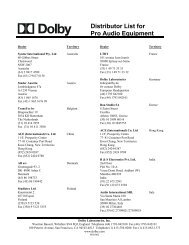Frequently asked QUESTIONS about DOLBY DIGITAL
Frequently asked QUESTIONS about DOLBY DIGITAL
Frequently asked QUESTIONS about DOLBY DIGITAL
Create successful ePaper yourself
Turn your PDF publications into a flip-book with our unique Google optimized e-Paper software.
Laboratories is encouraging the<br />
use on program packaging of the<br />
channel format symbols shown in<br />
Figure 3.<br />
In addition, to prevent<br />
confusion at playback, data<br />
identifying the original<br />
production format of a program’s<br />
soundtrack is incorporated right<br />
into the Dolby Digital data<br />
stream. Some Dolby Digital<br />
decoder units use this data to<br />
display on the control panel the<br />
type of soundtrack you’re<br />
listening to (see Figure 4).<br />
11. Do all program<br />
sources with Dolby<br />
Digital decoding provide<br />
5.1-channel sound?<br />
As with Dolby Digital program<br />
material, the phrase “Dolby<br />
Digital” on a component such as<br />
a DVD player means only that it<br />
incorporates Dolby Digital<br />
decoding; it does not indicate the<br />
number of channels.<br />
Many program sources,<br />
including DVD players and digital<br />
cable set-top boxes, provide a<br />
built-in two-channel Dolby Digital<br />
decoder with analog stereo<br />
outputs (see question 7). For 5.1channel<br />
playback, most units<br />
have a separate digital output<br />
that provides the undecoded<br />
Dolby Digital signal (data stream)<br />
for connection to an external<br />
unit, such as an A/V receiver, that<br />
has its own 5.1-channel Dolby<br />
Digital decoder. See Figure 5.<br />
Some DVD players do pro-<br />
Figure 5: Most DVD-Video players provide<br />
stereo (two-channel) analog audio outputs (left),<br />
plus at least one Dolby Digital output (right).<br />
The unit above has two different kinds of Dolby<br />
Digital outputs, co-ax and optical; see question<br />
18 on page 4 for advice on which to use when<br />
you have the choice.<br />
vide a built-in Dolby Digital 5.1channel<br />
decoder with multiple<br />
analog outputs that can be<br />
connected directly to a “Dolby<br />
Digital-ready” receiver, as<br />
described in question 12, for 5.1channel<br />
sound. However, you will<br />
not be able to use the internal<br />
Dolby Digital decoder for other<br />
program sources, and these<br />
players don’t usually offer the full<br />
range of options provided by<br />
external Dolby Digital decoder<br />
units. On the other hand, they are<br />
an inexpensive way to upgrade to<br />
5.1-channel Dolby Digital initially,<br />
and provide a digital output so<br />
that you can later bypass the<br />
built-in decoder and use an<br />
external one.<br />
12. How do I convert my<br />
current Dolby Surround<br />
Pro Logic system for 5.1channel<br />
playback?<br />
If your current system<br />
consists of separate audio<br />
components, you will need a 5.1channel<br />
Dolby Digital decoder<br />
and a six-channel preamplifier<br />
Figure 6-a.<br />
Figure 6-c.<br />
Figure 6-b.<br />
Figure 6-d.<br />
Figure 6. Converting to 5.1-channel playback.<br />
(available separately or<br />
combined in one convenient<br />
unit). The preamplifier’s outputs<br />
will plug into your existing power<br />
amplifiers (see Figure 6-a).<br />
If you have an older,<br />
integrated A/V receiver with<br />
Dolby Surround Pro Logic that<br />
does not provide external inputs<br />
to its built-in amplifiers, you have<br />
two choices. You can replace it<br />
with a new receiver incorporating<br />
a 5.1-channel Dolby Digital<br />
decoder, or add an external<br />
Dolby Digital decoder unit that<br />
includes center, left surround,<br />
and right surround amplifiers to<br />
use in place of those in your<br />
receiver (which will continue to<br />
power the left and right front<br />
speakers). This same solution<br />
also works for upgrading a<br />
conventional stereo system (see<br />
Figure 6-b).<br />
3


